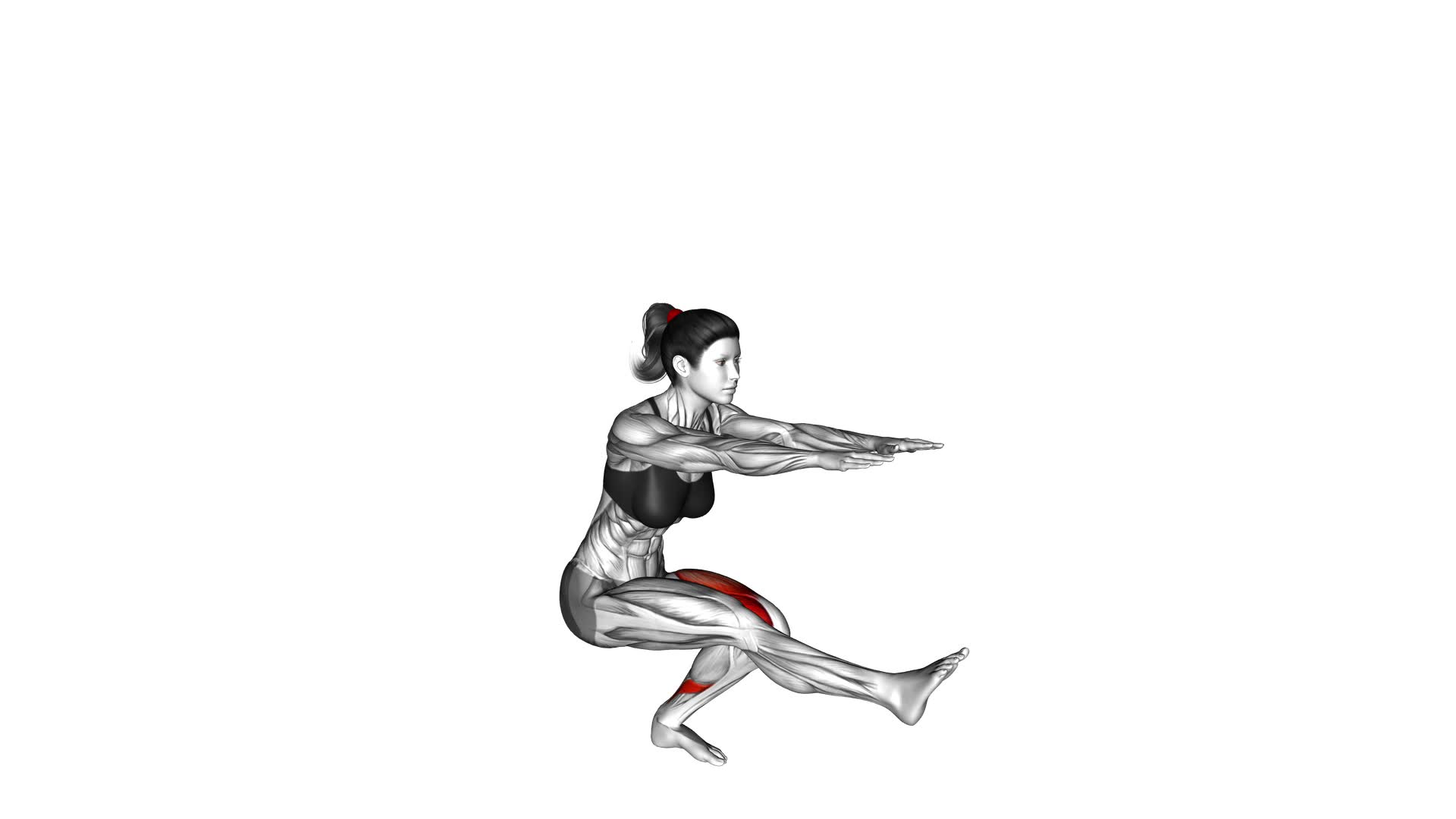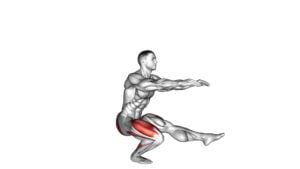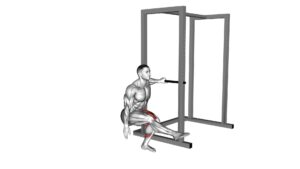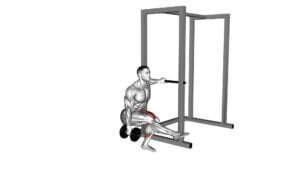Single Leg Squat (pistol) (female) – Video Exercise Guide & Tips

Looking to strengthen your legs and improve balance? Check out this video exercise guide for the single leg squat, also known as the pistol squat.
Watch This Exercise Video
This exercise targets your lower body muscles while challenging your stability and balance. Watch the video for proper form and technique, as well as tips to avoid common mistakes.
Whether you're a beginner or advanced, this exercise can be modified to suit your fitness level. Get ready to level up your leg workout!
Key Takeaways
- Single leg squats improve lower body strength and target specific muscles such as quadriceps, hamstrings, and glutes.
- Proper form and technique are important for maintaining hip and knee alignment, balance, and stability.
- Common mistakes to avoid include lack of proper form, neglecting proper breathing technique, and inconsistent rhythm and breathing throughout the exercise.
- Progressions and modifications can be made by starting with support, adding resistance, or using variations such as TRX suspension trainer or performing against a wall.
Benefits of the Single Leg Squat
You can experience a range of benefits by incorporating the single leg squat into your workout routine. One of the main benefits is that it helps improve lower body strength. By focusing on one leg at a time, you're able to target specific muscles such as the quadriceps, hamstrings, and glutes. This exercise requires a great deal of stability and balance, which activates the smaller stabilizer muscles in your legs, helping to strengthen them as well.
In addition to improving lower body strength, the single leg squat also helps with injury prevention. By working on your stability and balance, you're less likely to experience falls or accidents that can lead to injuries. This exercise also helps to strengthen the muscles around your knees, which can help prevent knee injuries, such as ligament tears or strains.
Incorporating the single leg squat into your routine can be done by starting with bodyweight squats and gradually adding resistance as you get stronger. It's important to maintain proper form throughout the exercise to maximize the benefits and prevent injuries.
Proper Form and Technique
To perform the single leg squat with proper form and technique, there are specific points you need to focus on.
First, ensure that your hip and knee alignment is correct throughout the movement to prevent any strain or injury.
Additionally, maintaining balance and stability is crucial, so engage your core and keep your upper body upright.
Hip and Knee Alignment
Achieving proper hip and knee alignment is crucial for performing the single leg squat (pistol) exercise effectively. To improve hip strength and prevent knee injuries, it's important to focus on the following:
- Hip Alignment: Ensure that your hip is in line with your knee and ankle throughout the movement. This will help distribute the load evenly and avoid unnecessary strain on the knee joint.
- Knee Tracking: Maintain proper knee tracking by keeping it aligned with the second toe. Avoid allowing the knee to collapse inward or outward, as this can put stress on the knee ligaments and increase the risk of injury.
Balance and Stability
Maintaining balance and stability is essential for performing the single leg squat (pistol) exercise effectively. When you have good balance and stability, you're able to maintain proper form and technique throughout the movement, which is crucial for targeting the correct muscles and preventing injury.
To improve your balance and stability during the single leg squat, focus on strengthening your core muscles. Your core acts as a stabilizer and helps to keep your body aligned and steady.
Additionally, working on your posture can also enhance your balance and stability. By keeping your spine straight and shoulders back, you create a solid foundation for the exercise.
Now that you understand the importance of balance and stability, let's move on to the next section and discuss common mistakes to avoid.
Common Mistakes to Avoid
Avoid these 3 common mistakes while performing the single leg squat (pistol) exercise to ensure that you're maximizing your results and minimizing the risk of injuries.
Here are the common mistakes to avoid:
- Lack of proper form: Maintaining proper form is crucial when performing the single leg squat. Make sure to keep your torso upright, engage your core, and lower yourself down with control. Avoid leaning forward or rounding your back, as this can put unnecessary strain on your lower back and knees.
- Neglecting proper breathing technique: Breathing correctly during the exercise is essential for maintaining stability and preventing injuries. Remember to inhale deeply as you lower yourself down and exhale forcefully as you push back up. This will help you engage your core muscles and stabilize your body throughout the movement.
- *Pro tip:* Practice diaphragmatic breathing, where you breathe deeply into your belly rather than shallow chest breathing. This will help you maintain a stable core and improve your balance during the exercise.
- *Pro tip:* Counting your breaths can also help you maintain a consistent rhythm and ensure that you're breathing properly throughout the exercise.
Progressions and Modifications
To advance your single leg squat (pistol) exercise, you can incorporate progressions and modifications to challenge your muscles even further.
If you're a beginner, start with progressions that help you build strength and stability. One option is to use a chair or bench for support. Begin by sitting on the chair with one leg extended in front of you and the other leg grounded. Slowly stand up using the grounded leg while keeping the extended leg straight. Lower yourself back down with control. This modified version allows you to focus on the movement and gradually build up strength in your legs.
Once you feel comfortable with the chair or bench modification, you can progress to doing the single leg squat without any support. Start by standing on one leg with the other leg extended in front of you. Lower yourself down into a squat position while keeping your extended leg straight. Focus on maintaining good form and control throughout the movement.
As you become more advanced, you can add resistance by holding dumbbells or using a resistance band around your thighs to increase the challenge.
Remember to always listen to your body and progress at a pace that's comfortable for you. It's important to maintain proper form and avoid any pain or discomfort during the exercise.
Tips for Increasing Stability and Balance
Improve your stability and balance by focusing on engaging your core muscles during the single leg squat (pistol) exercise. By strengthening your core, you create a solid foundation for your body, allowing for better stability and balance during this challenging exercise.
Here are some tips to help you increase your stability and balance:
- Perform exercises for core strength: Incorporate exercises such as planks, Russian twists, and bicycle crunches into your workout routine. These exercises target your abdominal muscles, lower back, and obliques, helping to improve your overall core strength.
- Work on improving ankle mobility: Ankle mobility plays a crucial role in maintaining stability and balance during the single leg squat. Incorporate ankle mobility exercises into your warm-up routine, such as ankle circles and calf stretches. Additionally, consider using a foam roller or lacrosse ball to massage your calves and ankles, helping to loosen up any tightness and improve mobility.
Incorporating the Single Leg Squat Into Your Workout Routine
Include the single leg squat (pistol) exercise in your workout routine for a challenging lower body workout. This exercise not only targets your quadriceps, hamstrings, and glutes but also improves your balance and stability. To make the single leg squat more challenging, you can incorporate weights into the exercise. Hold a dumbbell or kettlebell in front of your chest or use a barbell on your back. This will increase the resistance and intensity of the exercise, helping you build strength and muscle.
If you're a beginner, there are variations of the single leg squat that you can start with. One variation is to use a TRX suspension trainer for support. Hold onto the handles and use them to assist you as you lower down into the squat. Another variation is to perform the single leg squat with your back against a wall. This will provide additional support and stability as you work on mastering the movement.
Remember to start with a weight that's challenging but manageable. Focus on maintaining good form throughout the exercise and gradually increase the weight as you get stronger.
Incorporating the single leg squat into your workout routine will help you develop lower body strength, improve balance, and enhance overall athletic performance.
Frequently Asked Questions
How Many Sets and Reps Should I Do When Incorporating Single Leg Squats Into My Workout Routine?
When incorporating single leg squats into your workout routine, it's important to start with a manageable number of sets and reps.
Begin with 2-3 sets of 8-12 reps per leg, focusing on proper form and control.
As you progress, you can gradually increase the intensity by incorporating weights or trying different variations of single leg squats.
Remember to listen to your body and adjust the number of sets and reps accordingly.
Can I Do Single Leg Squats if I Have Knee Pain or an Injury?
If you have knee pain or an injury, it's important to modify the single leg squat exercise to avoid further discomfort. There are several variations you can try, such as using a support or reducing the range of motion.
Single leg squats are beneficial for overall strength and stability, as they engage multiple muscles and improve balance. However, always consult with a healthcare professional or physical therapist before incorporating them into your workout routine.
Are There Any Specific Muscles That Single Leg Squats Target?
When you perform single leg squats, there are specific muscles that are targeted. This exercise primarily works your quadriceps, hamstrings, glutes, and core muscles.
It also helps improve your balance and stability.
There are various variations and modifications you can try to make the exercise more challenging or suitable for your fitness level. These include using a bench or chair for support, holding weights for added resistance, or performing the exercise with a slower tempo.
How Long Does It Take to Progress From Assisted Single Leg Squats to Unassisted Single Leg Squats?
To progress from assisted single leg squats to unassisted ones, the time it takes varies from person to person. It depends on factors like strength, balance, and flexibility.
However, with regular practice and consistency, you can expect to see progress within a few weeks to a few months.
It's important to start with proper form and gradually increase difficulty by using variations like holding weights or changing the range of motion.
Remember to focus on correct technique and listen to your body to prevent injury and maximize the benefits of this exercise.
Can I Do Single Leg Squats Every Day, or Should I Incorporate Rest Days Into My Routine?
You should incorporate rest days into your routine when doing single leg squats. While they've many benefits, such as improving leg strength and stability, overtraining can lead to muscle fatigue and injury. Rest days allow your muscles to recover and grow stronger.
Additionally, it's important to vary your single leg squat routine to prevent plateaus and keep challenging your muscles. Try different variations like using a stability ball or adding weights to continue progressing.
Conclusion
The single leg squat, also known as the pistol squat, is a challenging exercise that offers numerous benefits. By improving strength, stability, and balance, it can help enhance athletic performance and reduce the risk of injury.
Proper form and technique are essential to maximize the effectiveness of this exercise and avoid common mistakes. With progressions and modifications, individuals can tailor the single leg squat to their fitness level.
By incorporating this exercise into your workout routine, you can take your fitness to the next level.

Author
Years ago, the spark of my life’s passion ignited in my mind the moment I stepped into the local gym for the first time. The inaugural bead of perspiration, the initial endeavor, the very first surge of endorphins, and a sense of pride that washed over me post-workout marked the beginning of my deep-seated interest in strength sports, fitness, and sports nutrition. This very curiosity blossomed rapidly into a profound fascination, propelling me to earn a Master’s degree in Physical Education from the Academy of Physical Education in Krakow, followed by a Sports Manager diploma from the Jagiellonian University. My journey of growth led me to gain more specialized qualifications, such as being a certified personal trainer with a focus on sports dietetics, a lifeguard, and an instructor for wellness and corrective gymnastics. Theoretical knowledge paired seamlessly with practical experience, reinforcing my belief that the transformation of individuals under my guidance was also a reflection of my personal growth. This belief holds true even today. Each day, I strive to push the boundaries and explore new realms. These realms gently elevate me to greater heights. The unique combination of passion for my field and the continuous quest for growth fuels my drive to break new ground.



